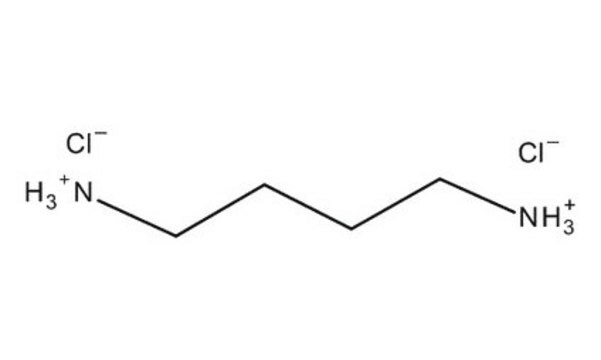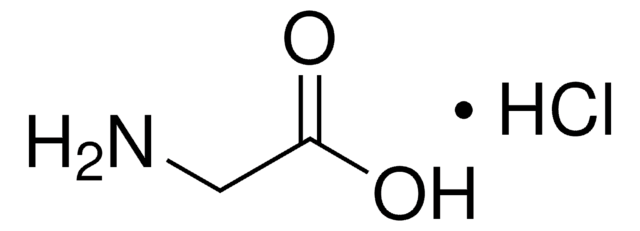32810
Putrescine dihydrochloride
purum, ≥99.0% (AT)
Synonyme(s) :
1,4-Butanediamine dihydrochloride, 1,4-Diaminobutane dihydrochloride, Tétraméthylènediamine dihydrochloride
About This Item
Produits recommandés
Qualité
purum
Niveau de qualité
Essai
≥99.0% (AT)
Forme
powder
Pf
280 °C (dec.) (lit.)
Solubilité
water: soluble 1 g/10 mL, clear, colorless
Chaîne SMILES
Cl[H].Cl[H].NCCCCN
InChI
1S/C4H12N2.2ClH/c5-3-1-2-4-6;;/h1-6H2;2*1H
Clé InChI
XXWCODXIQWIHQN-UHFFFAOYSA-N
Vous recherchez des produits similaires ? Visite Guide de comparaison des produits
Application
- Nanocomposite PLA/C20A nanoclay by ultrasound-assisted melt extrusion for adsorption of uremic toxins and methylene blue dye: This study explored the modification of nanoclay with 1,4-diaminobutane dihydrochloride for adsorptive applications, showing enhanced performance in toxin removal (Andrade-Guel et al., 2021).
- The Total Synthesis of Spermine Alkaloid Kukoamine Bimesylate: This paper details the synthetic route of spermine alkaloid derivatives using 1,4-diaminobutane dihydrochloride, highlighting methods applicable in medicinal chemistry (Dong, 2018).
Actions biochimiques/physiologiques
Mention d'avertissement
Danger
Mentions de danger
Classification des risques
Acute Tox. 2 Inhalation - Acute Tox. 3 Dermal - Acute Tox. 4 Oral - Eye Dam. 1 - Skin Corr. 1B
Code de la classe de stockage
6.1A - Combustible acute toxic Cat. 1 and 2 / very toxic hazardous materials
Classe de danger pour l'eau (WGK)
WGK 1
Équipement de protection individuelle
dust mask type N95 (US), Eyeshields, Gloves
Faites votre choix parmi les versions les plus récentes :
Déjà en possession de ce produit ?
Retrouvez la documentation relative aux produits que vous avez récemment achetés dans la Bibliothèque de documents.
Les clients ont également consulté
Notre équipe de scientifiques dispose d'une expérience dans tous les secteurs de la recherche, notamment en sciences de la vie, science des matériaux, synthèse chimique, chromatographie, analyse et dans de nombreux autres domaines..
Contacter notre Service technique













